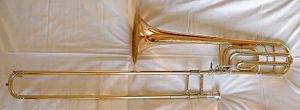Trombone
A trombone is a type of musical instrument and, along with the trumpet, is a member of the brass family. Sounds are produced in the same way as a trumpet by vibrating the mouthpiece. Unlike the trumpet, which uses a series of hand-operated valves to change the pitch, the trombone uses a long slide to vary the note played. This gives the instrument the ability to "slide" between notes and makes for an expressive sound that can be likened to the human voice. Despite the apparent simplicity, tromboning can be difficult to master due to the combination of repetitive arm work and continuous blowing. An experienced tromboner is a popular addition to many bands though and can contribute to an explosive finale.
The trombone is suited to a wide variety of musical styles, including jazz, big band and marching bands. Military bands often contain one or more trombonists.
History
The trombone is essentially the same instrument as the late medieval sackbut, an instrument which had a major role in the royal ceremonial bands of the day. Up until the late baroque period (mid-1700s) it appeared mainly as a vocal/choral accompaniment in masses and operas and rarely in purely instrumental works. With the death of Handel (1759) it was little used for a generation and when it reappeared, it was as the Italian “trombone”.
Mozart used it to great effect in his last operas and his unfinished Requiem, as did Weber, and with Beethoven and Schubert – writing in the early 19th century – it began appearing in symphonic works. It found its dramatic niche in the works of Hector Berlioz and Wagner, and the later Romantics; although later French and Italian composers tended to ignore the bass versions of the instrument, preferring the tuba.
It has always been a major component of folk and village bands, from whence the American and European brass bands derived.
